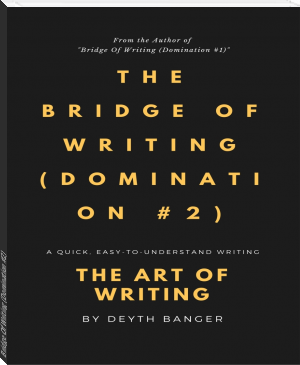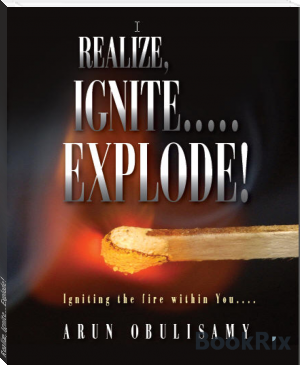Bridge Of Writing (Domination #2), DeYtH Banger [read my book .TXT] 📗

- Author: DeYtH Banger
Book online «Bridge Of Writing (Domination #2), DeYtH Banger [read my book .TXT] 📗». Author DeYtH Banger
Third person omniscient: The story is told using he/she/it. In omniscient POV, the narrative is told from multiple characters’ perspectives, though indirectly. Pros: Allows you to explore multiple characters’ thoughts and motivations. Cons: transitioning between different characters’ perspectives must be handled with care or the reader could lose track of who is the viewpoint character.
Third person limited:The story is told using he/she but from one character’s perspective. Pros: The reader enjoys the intimacy of a single character’s perspective. Cons: Other characters’ views and actions are only understood through the perceptions of the viewpoint character.
As you can see, choosing POV requires thinking about both who you want to tell your story and what this decision will exclude. Think about the scenario of your story and what would fit best. Virginia Woolf, writing a dinner party scene, alternates between diners’ perspectives using third person omniscient. This creates a strong sense of a group of very different people coming together and bringing contrasting desires, opinions and impressions to the table.
6: Write your story as a one page synopsis
This might seem like a dubious idea. After all, how will you know where the story will take you once you start writing? The truth is that even just attempting this as an exercise will give you an idea of the strong and weak points of your story idea: Will there be sufficient climax? Is there an intriguing story that the initial premise makes possible?
You should at least try to write your short story in condensed form first for other reasons, too:
You’ll begin with the bare essentials – having the most important elements at the centre of your process will stop you from writing boring filler
You’ll be better able to work out the number and sequence of scenes you’ll need to do your topic and themes justice
Joe Bunting advocates breaking your story into a scene list so that you have a clear overview of the structure of your story and the parts that require additional work. If you don’t have a clear outline of your story to begin with and prefer to start writing immediately, you can do this at a later stage too.
7: Write a strong first paragraph
Joe Bunting quote on how to write a short storyYou don’t necessarily need to begin writing your story from the first paragraph. The chances are that you will need to go back and revise it substantially so that it matches with the rest of the story when you are finished. Bunting actually advises against starting a short story with the first paragraph because the pressure to create a great hook can inhibit you from making headway. Says Bunting:
‘Instead, just write. Just put pen to paper. Don’t worry about what comes out. It’s not important. You just need to get your short story started.’
Whether you are intent on starting with the beginning or prefer to follow Bunting’s advice, here are important things to remember about your opening paragraph:
It should foreshadow the events of the story by introducing core subjects and themes (Garcia Marquez’s story begins with the discovery of the drowned man’s body).
It should pique the reader’s interest and elicit questions (in the unsettling discovery of Marquez’s drowned man two immediate questions arise: ‘Who is he? What does the discovery portend?’)
It should not waste time – the limited word count of a short story requires you to get to the meat of the story faster
Discussing writing catchy first paragraphs, Jerz and Kennedy suggest:
‘The first sentence of your narrative should catch your reader’s attention with the unusual, the unexpected, an action, or a conflict. Begin with tension and immediacy.’
8: Create a strong climax and resolution for a satisfying story arc
The climax of a story is crucial in long as well as short fiction. In short stories in particular, the climax helps to give the story a purpose and shape – a novel can meander more. Many short story writers have favoured a ‘twist in the tale’ ending (the American short story author O. Henry is famous for these).
The climax could be dramatically compelling. It could be the reader’s sudden realisation that a character was lying, for example, or an explosive conflict that seemed inevitable from the first page.
Writing a good short story ending can be achieved many ways. Besides using an element of surprise you can have an ending that:
Is open: The reader must piece together the final pages’ implications
Is resolved: The meaning of the outcome is clear and fits the preceding events’ pattern of cause and effect
Returns to the beginning: An opening image or action returns and the story is given a circular structure
These are just three possible types of short story resolution. After the final full stop the crucial revision process begins:
9: How to write a short story that gets published: Rewrite for clarity and structure
Revising is just as important when writing short stories as it is when writing novels. A polished story greatly increases your chance of publication. While revising your short story, see to it that:
The expectations set up on the first page are dealt with subsequently (see ‘Chekhov’s Gun’)
All information, characters and scenes that don’t contribute to the main story focus are cut
Each line adds something significant to the overarching effect of the story
See further pointers on editing your own writing.
10: Pick a great story title and submit your revised story to contests and publishers
Choosing a title for your short story should come last because you will have the entire narrative to draw on. A great title achieves at least two things:
It creates intrigue (Faulkner’s ‘A Rose for Emily’ makes the reader ask ‘Who is Emily and what occasions this gift of a single rose?’)
It establishes the key characters, subjects, symbols or objects of the short story (such as ‘The Handsomest Drowned Man in the World’)
Once you have created an alluring title, you can set about submitting your story to publications. If you are not yet an established author, it may be easier to get published on a digital platform such as an online creative writing journal. Spread the net wide, however, and submit wherever your short story meets guidelines and topical preferences. This will maximize the chance your short story will be published.

Casual readers and signed up members alike on Now Novel share a common struggle: Finding time to write. Or, rather, making time to write, since that’s what it boils down to. Between simple life hacks and prioritizing your writing, you can finish your story. Here are several tips for how to find time to write:
1. Create distraction-free writing sessions
Award-winning science fiction writer John Scalzi offers the following writing advice:
Turn off the TV if it tempts you Write after the children are in bed if you have a family or get up early to write before work If you aren’t a morning person, use weekends instead (this is how Scalzi was able to write his debut)If you want to write, you will find the time. Even if it is only 250 words per day you jot down on the bus. Try work your way up to 800 words per day – the length of a critique submission on Now Novel. Although this might not seem much, you’ll have over 4000 words written within a month.

2. Keep your writing appointments
The late poet and civil rights activist Maya Angelou was strict about showing up for writing appointments with herself. In an interview for the book Writers Dreaming, she said:
‘I may write for two weeks ‘the cat sat on the mat, that is that, not a rat,’ you know. And it might be just the most boring and awful stuff. But I try. When I’m writing, I write. And then it’s as if the muse is convinced that I’m serious and says, ‘Okay. Okay. I’ll come.’
What Angelou describes is the simple art of showing up, despite passing internal or external discouragements. It might feel like a waste of time when you’re not churning out sentences you think will make your final edit. Yet even ‘blocked’ days are important groundwork, as your mind is sifting through ideas and impressions to find the story’s thread.
3. Learn the art of ‘snap writing’
Science fiction author Danie Ware recommends what she calls ‘snap writing.’ Much writing advice advocates sticking to a relentless routine. There’s good reason for this. Chunking up a project into manageable tasks ensures you chip away at it consistently, whether fast or slow.
Ware’s view, though, is that this is damaging to productivity when you become obsessed with making every writing session meet your ideal conditions.
Instead, Ware says, grab twenty minutes here, a half hour there — a full hour somewhere if you are particularly lucky.
In order to ‘snap write’ effectively, Ware suggests doing this at least once a day. That way you can always leap right back into your story and pick up where you left off.
Get the most out of snap writing and combine it with Earnest Hemingway’s approach to picking up where you left off. Stop mid-sentence at the end of a snap writing session so that you have an urgent desire to continue and finish when you resume.
4. Get help
Ursula Le Guin shares that between herself and her husband, they had three jobs. Her husband was a professor, she was a novelist, and between the two of them they shared the third – raising a family.
Though neither of them would have coped well with two jobs alone, according to Le Guin, they could and did split three jobs between them.
Find ways to share chores and duties between immediate family members so there are more pockets of time that are purely yours to use. Find other ways to streamline daily non-negotiable responsibilities. Time management is key to making good progress on longer fiction. Delegate when time is tight.

5. Just do it
A lot of advice about finding time to write boils down to simply doing it. You have to turn off the TV, turn down the occasional lunch date or sacrifice that extra half-hour of sleep. Children’s writer Allison Tait points out a simple truth: Writing is not convenience. It’s something of a luxury, even though for committed writers it is also a necessity.
As writers struggling to find time to write, we might feel as though other writers have some sort of ‘secret formula’; access to hours that we do not. The truth is, as Tait says, starting something and making it a habit isn’t easy. It can take anywhere from a few weeks to months to make it an everyday part of your life, so the sooner you start, the closer you are to achieving your goal.





Comments (0)